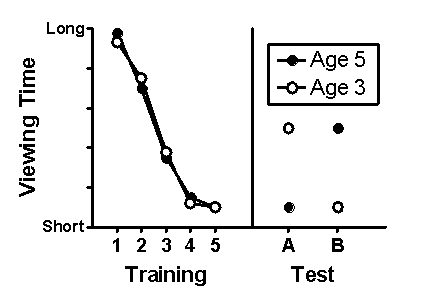Scenario I
Scenario I is based on and presents fabricated results consistent with the following study:
Kim, I. K., & Spelke, E. S. (1992) . Infants' sensitivity to effects of gravity on visual object motion. Journal of Experimental Psychology: Human Perception and Performance, 18(2) , 385-393.
Kim and Spelke (1992) investigated the extent to which infants have expectancies of gravitational effects on visual object motion. Three- and five-month-old infants repeatedly watched a video of a ball accelerating as it rolled down an incline until they spent little time actively looking at it. Subsequently, two types of test trials were conducted in randomized order. Type A test trials consisted of a ball slowing down as it rolled up an incline. Type B test trials consisted of a ball slowing down as it rolled down an incline. During all trials, the amount of time looking at each visual display was recorded. Fabricated data consistent with the major finding of this study are presented in Figure 11.1.
Figure 11.1 
-(Scenario I) Which is the likely explanation for the decreased looking time across training trials?
Definitions:
Union Contracts
Agreements negotiated between employers and labor unions that outline wages, working conditions, and other employment terms for the workers represented by the unions.
Human Resource Planning
Strategic alignment of an organization's human resources with its business goals, including workforce planning, recruiting, and training.
Competencies
A set of defined skills, knowledge, abilities, and attributes that are necessary for successful performance in a job or role.
Hrm Programs
Human Resource Management initiatives designed to maximize employee performance in service of an organization's strategic objectives.
Q13: Which of these belongs to the class
Q32: Who developed the two-factor theory of intelligence?<br>A)Louis
Q58: In just 3 or 4 years, the
Q60: Recent studies have suggested that infants acquire
Q63: Well over 50 percent of American infants
Q63: The WAIS is a modern intelligence test
Q73: Aging produces more deficits in long-term memory
Q78: Most of the time we develop our
Q99: During the sensorimotor stage of development, infants
Q135: Joey wants to pull Becky's pigtails to